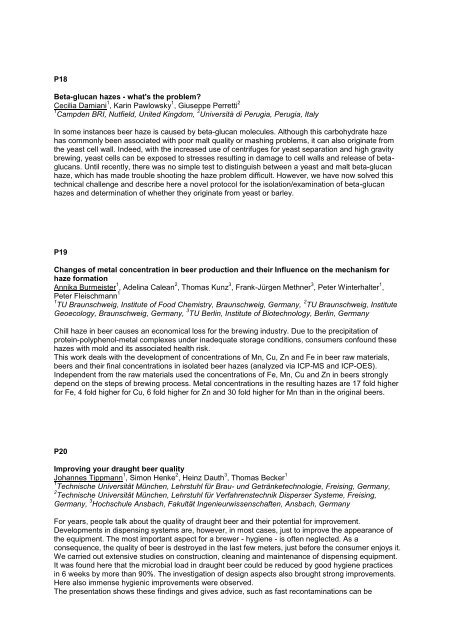here - the 34th European Brewery Convention
here - the 34th European Brewery Convention
here - the 34th European Brewery Convention
Create successful ePaper yourself
Turn your PDF publications into a flip-book with our unique Google optimized e-Paper software.
P18<br />
Beta-glucan hazes - what's <strong>the</strong> problem<br />
Cecilia Damiani 1 , Karin Pawlowsky 1 , Giuseppe Perretti 2<br />
1 Campden BRI, Nutfield, United Kingdom, 2 Università di Perugia, Perugia, Italy<br />
In some instances beer haze is caused by beta-glucan molecules. Although this carbohydrate haze<br />
has commonly been associated with poor malt quality or mashing problems, it can also originate from<br />
<strong>the</strong> yeast cell wall. Indeed, with <strong>the</strong> increased use of centrifuges for yeast separation and high gravity<br />
brewing, yeast cells can be exposed to stresses resulting in damage to cell walls and release of betaglucans.<br />
Until recently, t<strong>here</strong> was no simple test to distinguish between a yeast and malt beta-glucan<br />
haze, which has made trouble shooting <strong>the</strong> haze problem difficult. However, we have now solved this<br />
technical challenge and describe <strong>here</strong> a novel protocol for <strong>the</strong> isolation/examination of beta-glucan<br />
hazes and determination of whe<strong>the</strong>r <strong>the</strong>y originate from yeast or barley.<br />
P19<br />
Changes of metal concentration in beer production and <strong>the</strong>ir Influence on <strong>the</strong> mechanism for<br />
haze formation<br />
Annika Burmeister 1 , Adelina Calean 2 , Thomas Kunz 3 , Frank-Jürgen Methner 3 , Peter Winterhalter 1 ,<br />
Peter Fleischmann 1<br />
1 TU Braunschweig, Institute of Food Chemistry, Braunschweig, Germany, 2 TU Braunschweig, Institute<br />
Geoecology, Braunschweig, Germany, 3 TU Berlin, Institute of Biotechnology, Berlin, Germany<br />
Chill haze in beer causes an economical loss for <strong>the</strong> brewing industry. Due to <strong>the</strong> precipitation of<br />
protein-polyphenol-metal complexes under inadequate storage conditions, consumers confound <strong>the</strong>se<br />
hazes with mold and its associated health risk.<br />
This work deals with <strong>the</strong> development of concentrations of Mn, Cu, Zn and Fe in beer raw materials,<br />
beers and <strong>the</strong>ir final concentrations in isolated beer hazes (analyzed via ICP-MS and ICP-OES).<br />
Independent from <strong>the</strong> raw materials used <strong>the</strong> concentrations of Fe, Mn, Cu and Zn in beers strongly<br />
depend on <strong>the</strong> steps of brewing process. Metal concentrations in <strong>the</strong> resulting hazes are 17 fold higher<br />
for Fe, 4 fold higher for Cu, 6 fold higher for Zn and 30 fold higher for Mn than in <strong>the</strong> original beers.<br />
P20<br />
Improving your draught beer quality<br />
Johannes Tippmann 1 , Simon Henke 2 , Heinz Dauth 3 , Thomas Becker 1<br />
1 Technische Universität München, Lehrstuhl für Brau- und Getränketechnologie, Freising, Germany,<br />
2 Technische Universität München, Lehrstuhl für Verfahrenstechnik Disperser Systeme, Freising,<br />
Germany, 3 Hochschule Ansbach, Fakultät Ingenieurwissenschaften, Ansbach, Germany<br />
For years, people talk about <strong>the</strong> quality of draught beer and <strong>the</strong>ir potential for improvement.<br />
Developments in dispensing systems are, however, in most cases, just to improve <strong>the</strong> appearance of<br />
<strong>the</strong> equipment. The most important aspect for a brewer - hygiene - is often neglected. As a<br />
consequence, <strong>the</strong> quality of beer is destroyed in <strong>the</strong> last few meters, just before <strong>the</strong> consumer enjoys it.<br />
We carried out extensive studies on construction, cleaning and maintenance of dispensing equipment.<br />
It was found <strong>here</strong> that <strong>the</strong> microbial load in draught beer could be reduced by good hygiene practices<br />
in 6 weeks by more than 90%. The investigation of design aspects also brought strong improvements.<br />
Here also immense hygienic improvements were observed.<br />
The presentation shows <strong>the</strong>se findings and gives advice, such as fast recontaminations can be





